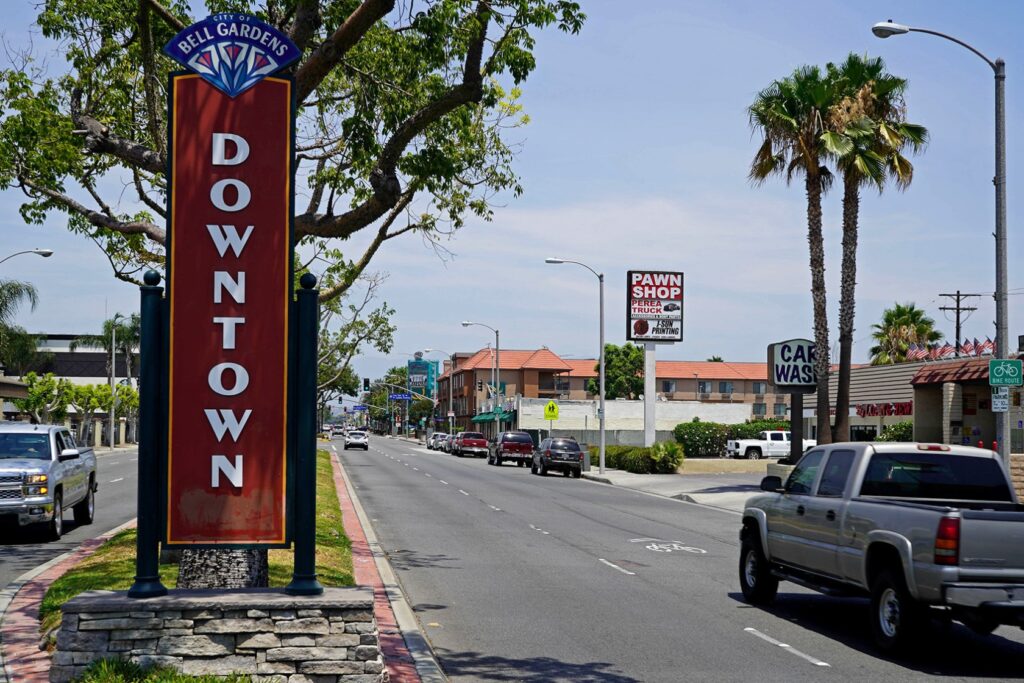
By: Joe Brizzolara
The Bell Gardens City Council passed a permanent ordinance Monday to limit rent increases and ban no-fault evictions as other cities like Pomona, Pasadena, and Santa Monica also consider action to lower rent increases.
The ordinance, which received a unanimous 5-0 vote, will cap annual rent increases at 4% or half of the increase in the consumer price index (CPI), whichever is less. The CPI charts changes in the prices of a range of goods and services to determine the rate of inflation.
The ordinance also bars landlords from evicting tenants for any reasons other than the ten listed as “just cause” otherwise they must provide relocation assistance to the tenant. According to the ordinance, lawful reasons to evict a tenant include failure to pay rent, causing a nuisance, or violating a rental agreement.
“It has been an arduous and very long conversation,” said Councilmember Alejandra Cortez after the vote and as cheers erupted outside the council chambers. Cortez congratulated her colleagues and community members.
“Today we made history… Sí, se puede!” she said.
An alternative motion, which would have capped rents at 3%, failed after receiving a 2-3 vote with Mayor Maria Pulido and councilmembers Cortez and Lisseth Flores voting no.
Along with California Latinas for Reproductive Justice (CLRJ) and East Yard Communities for Environmental Justice, Union de Vecinas (UdV) Bell Gardens (a Bell Gardens community advocacy group) has been pushing for rent stabilization since 2020. They say that the law will combat displacement of longtime Bell Gardens residents and give security to economically vulnerable communities.
“This is one step closer to saving money,” said Martha Pineda, a community organizer with CLRJ, at a press conference held on Wednesday at Bell Gardens Veterans Park. “This is one step closer to sending our kids to college. This is one step closer to buying that house that Bell Gardens residents have always dreamed of.”
“We felt and fought the stress of the entire community,” said Estela Mata, a 27-year Bell Gardens resident and UdV member, in Spanish. “We were told stories about the community suffering and assured them of our support because we were also facing the same issues.”

Multiple residents told councilmembers about their difficulties paying rent leading up to Monday’s vote.
“I am struggling,” said Yovanny Umanzor, at an Aug. 8 public hearing. Umanzor is a 13-year resident of Bell Gardens who lives with his wife and two children. He says he paid $1,695 a month before the pandemic but after two rent increases, he’s looking at $1,995 a month. He’s had to dip into his savings to make ends meet. “What happens when my savings goes away?”
Before being elected to the council, Mayor Pro Tem Jorgel Chavez organized with UdV and was involved in the group’s initial discussions around rent stabilization.
“It’s about making sure we can keep families together, prevent homelessness, prevent the cost of housing from going up,” said Chavez, about his support for the ordinance in a phone interview prior to Monday’s vote.
“It’s not only needed in the City of Bell Gardens, I think it’s needed in (other) communities with a substantial amount of renters,” Chavez added.
In accordance with state law, the ordinance excludes units built after 1995, single-family homes, condominiums, and owner-occupied rentals with up to three units. Only 10% of Bell Gardens’s housing stock was built after 1995, according to city staff.
The largely working-class and Latino city is less than 2.5 square miles with a population approaching 40,000. According to city staff, renters represent 78% of households in Bell Gardens, with 58% of households being burdened by housing costs. City staff also reported that estimated average rents range from $932 per month for a one-bedroom unit to $2,675 per month for a three-bedroom unit. According to the U.S. Census, median household income is roughly $45,000, with over a quarter of residents living at or below the poverty line.
Councilmember Marco Barcena, a lead proponent of the ordinance and member of the city’s rent control ad hoc committee, thanked his colleagues for passing the renter protection.
“This is something I’m very happy about,” said Barcena. “Thank you for having the courage to stand up for the community.”
Monday’s vote concludes an over three-year process—paused due to the pandemic and accompanying renter protections enacted by the state—that began in March 2019 with a study session examining rent stabilization. In June 2021, and continuing through March of this year, a rent control ad hoc committee was formed which brought together tenant advocacy groups and rental property interests in a series of meetings and workshops. In April, a temporary rent increase freeze was implemented (renewed again in July) while a permanent ordinance was crafted.
The ordinance was opposed by local landlords and the Apartment Association of Greater Los Angeles (AAGLA), a lobbying group that represents rental property owners.
“We oppose all forms of rent control and housing regulations that adversely impact our members. Rent control ordinances, while they provide some temporary benefits for (current renters), are typically highly unbalanced ordinances,” said Daniel Yukelson, Executive Director of the AAGLA. “They always favor the renter and really harm the rental property owner financially.”
Several landlords said a cap on rent increases could threaten their ability to own rental property in the city.
“Housing simply has costs. When you cap rent below the inflation rate, then the costs begin to exceed the income of the building and it becomes impossible to maintain,” said Megan Edner, who owns four rental units in Bell Gardens.
Edner says that recently her building experienced flooding, which caused $150,000 in damages.
“We don’t even have the money to make these repairs… (me and my husband) ask ourselves, what are we even doing? Is this even worth it?” she said.
Pineda challenges this assessment.
“(Even) without rent control, maintenance and repairs aren’t being done,” said Pineda in a phone interview. She says she has received complaints from tenants concerning substandard housing such as broken garage doors that allow vermin to enter the unit and bathtubs in disrepair.
Pineda also highlights the fact that the California constitution guarantees landlords a “fair return” on their property. The California Supreme Court has continually held that local rent stabilization ordinances are legal as long as landlords are ensured “a just and reasonable return on their property.”
“If they’re not making at least a bit of profit, if they’re not (covering) the cost of investment, they can petition (for) a higher rent increase,” said Pineda about a provision in the ordinance which allows landlords to petition the city for a rate adjustment.
Yukelson argues that rent stabilization does not address long-term affordability as cities with rent stabilization ordinances also have some of the highest rents, largest unhoused populations, and housing shortages.
“Look at cities like Los Angeles and San Francisco and Santa Monica that have had these types of regulations in place for well over forty years,” Yukelson said in a phone interview. “In addition to housing shortages, (these cities) have the worst homelessness problems.”
“Owners need to charge more for vacant units to make up for the losses they’re experiencing on the rent controlled units,” he said. Yukleson also says that rent stabilization encourages rental property owners to remove their properties from the housing market.
California law prohibits cities from setting the starting rent on vacant units and allows landlords to evict tenants in rent stabilized units if they plan to get out of the rental business.
Yukelson supports means testing to ensure that tenants of rent stabilized units are in need of affordable housing and also argues that the government should be picking up the tab for addressing housing affordability, not landlords.
“Housing affordability is a societal issue and it’s not fair to target (rental property owners),” said Yukelson. “The government needs to provide rent subsidies… and help create more affordable housing.”
Other aspects of the law include a rental registry which will collect information including rental rates and vacancies, exemptions that allow landlords to raise rents above the 4% cap and avoid registration fees, and relocation assistance.
Landlords who reside in their rental property and own four or less units will be exempt from
registration fees, but will still be required to register, as long as they maintain the unit as their primary residence.
Councilmember Flores proposed this exemption saying that “not all landlords are bad… (this exemption will) give them a break because obviously they are small landlords that are still living in Bell Gardens.”
Another way landlords can get around the rent cap will be if they invest in capital improvements—substantial structural improvements to the property that primarily benefit the tenant and do not include regular maintenance or repair. Up to 50% of costs associated with capital improvements to a property will be allowed to be passed through to the tenant with a cap of 5% in annual rent increases until the improvement is paid off or after 60 months, whichever is sooner.
Yukelson points out that the Bell Gardens ordinance also has an unusual feature in his experience which allows landlords who are charging below 80% of market rate to charge an additional 3% increase until the 80% threshold is met.
In the event of no-fault eviction, landlords will be required to provide tenants with relocation assistance equal to three months rent or four months if the tenant is low-income, a senior, disabled, or families with minor children or a tenant of five years or more.
The rental registry and a rent board—whose primary function will be to settle tenant-landlord disputes—will be implemented starting next year. The city is currently recruiting a housing coordinator who will take a proactive role in educating the public about the ordinance, as well as working with staff to enforce the ordinance, according to City Manager Michael B. O’Kelly.
A fee study, expected to cost the city a minimum of $60,000, will determine how much rental property owners will be charged in registration fees, which will go towards costs associated with the rental registry, rent board, and staffing up the new rent stabilization division. The ordinance allows landlords to pass through 50% of the registration fee to tenants in a separately itemized monthly surcharge. Rent stabilized tenants living in the City of Los Angeles, which also has a 50% pass through of the fee, currently pay a monthly surcharge of $1.61.
The council will vote on the ordinance once more before it is formally passed. For additional information about Bell Gardens’s rent stabilization ordinance, contact the city’s Community Development Department at 562-806-7724.









